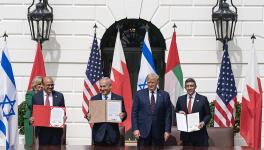Fresh Fighting in South Yemen As Groups Backed by Saudi and UAE Clash

Yemeni Prime Minister Ahmed bin Daghr
Clashes erupted between the United Arab Emirates (UAE)-backed southern separatists and troops loyal to Saudi Arabia-based President Abd-Rabbu Mansour Hadi in the coastal town of Aden on 28 January. According to hospital sources, around 12 people have been killed and 132 wounded. Both Saudi Arabia and UAE are part of the United States-backed international coalition that is fighting the Shia majority Houthi rebels in the North.
The fresh fighting began after the Southern Transitional Council (STC) tried to overtake the two bases from Prime Minister Ahmed bin Daghr’s government. Clashes started soon after the expiry of a deadline set last week by STC separatists for Hadi to dismiss the bin Daghr for corruption and mismanagement.
The STC was formed last year to further the cause of the former independent state of South Yemen. The bin Daghr government, calling the STC push as a ‘coup’, has asked its forces to ‘return to barracks’, but according to sources, if fighting continues his forces could leave anti-Houthi battle fronts to reinforce Aden.
“The military commanders leading the battle in the western part of Yemen have given short notice to Saudi and UAE to intervene to end the fighting in Aden. Otherwise they will leave the battlefront and move back to Aden to assist President Hadi and the government,” the source said.
Hani bin Braik, vice-president of the STC, blaming the Saudi-backed forces said, “They forced us to put on our military uniforms, although we told them we were non-violent. But we were ready.”
The International Committee of Red Cross said that violent clashes continued all night. “All night shooting in Aden #Yemen, including heavy weapons," Alexandre Faite, the head of the ICRC delegation in Yemen, said on Twitter. He added that “those in southern part of city, including (ICRC staff) still unable to get out.”
The clashes in the South further complicate the political dynamics in Yemen, which has already been reeling under catastrophic humanitarian crisis since the civil war broke out in 2015.
The international coalition had been bombing the country ruthlessly and has already destroyed Yemen’s vital infrastructure. The crisis is further exacerbated by the air and naval blockade by coalition forces cutting much-needed medical, food and fuel supplies. Experts argue the acts of coalition countries, including the US, amount to war crimes under international laws.
The International Committee of Red Cross (ICRC) and the World Health Organisation (WHO) have said that the world’s largest cholera outbreak combined with rising diphtheria cases have put the country’s population under severe risk. There have been more than 8,15,000 suspected cases of the disease and 2,156 deaths. And among the 4,000 suspected cases being reported daily, more than half of were children under 18.
Currently, Yemen, one of the poorest countries in the region, is divided between different fighting fractions. The Houthis, which overran much of the capital city Sanaa in 2014, control the North, while forces loyal to Hadi and backed by the international coalition made up of mostly Sunni countries control the Southern and Eastern part. Some regions are under Al-Qaeda forces and ISIS elements.
In December 2017, dynamics shifted in North Yemen as Houthi rebels killed Yemeni president Ali Abdullah Saleh after he shifted flanks to Saudis. Saleh had earlier sided with with Houthis in overthrowing the Hadi government.
Get the latest reports & analysis with people's perspective on Protests, movements & deep analytical videos, discussions of the current affairs in your Telegram app. Subscribe to NewsClick's Telegram channel & get Real-Time updates on stories, as they get published on our website.
























